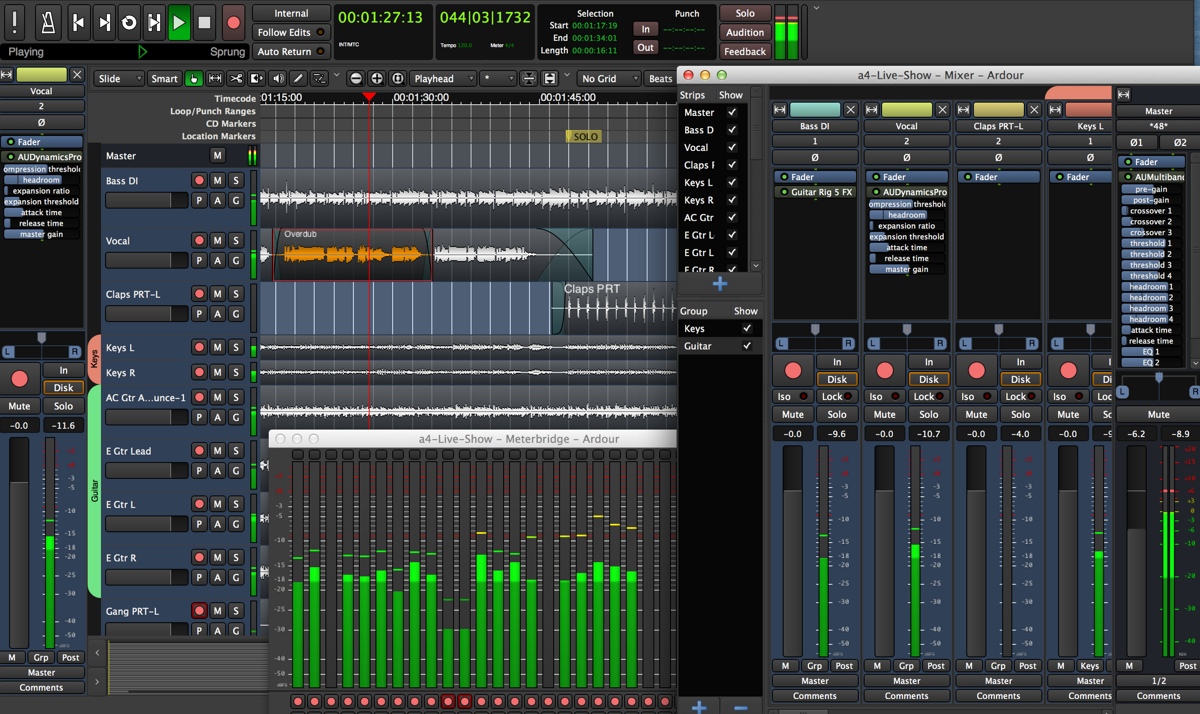
Ardor is a powerful and very complete digital audio workstation (DAW)
The new version of Ardor 7.0 was released recently and this is a version that comes with some improvements, the most important of which is «clip launching», in addition to the fact that some improvements have also been made in MIDI editing and mixing.
For those who are unfamiliar with Ardor, you should know that this application It is designed for multi-channel recording, sound processing and mixing. There is a multitrack timeline, an unlimited level of reversal of changes throughout the work with the file (even after closing the program), support for a variety of hardware interfaces.
The program is positioned as a free analog of ProTools, Nuendo, Pyramix and Sequoia professional tools.
Main new features of Ardor 7.0
In this new version that is presented of Ardor 7.0 the feature that stands out the most is the “clip launching” to create loop compositions (loops), which provides means to compile a composition in real time through the random arrangement of previously disordered fragments. A similar workflow is found in digital audio workstations like Ableton Live, Bitwig, Digital Performer, and Logic. New mode lets you experiment with sound by combining different loops of sound with individual samples and adjusting the result to the general rhythm.
Another change that stands out is the interface for loading sound samples and MIDI material of additional loop libraries. Libraries can be accessed through the Clips tab offered on the right hand side of the Cues and Edit pages. The basic set offers more than 8000 ready-to-use MIDI chords, over 5000 MIDI progressions, and over 4800 drum rhythms. You can also add loops and import data from third party collections like looperman.com.
In addition to that, we can also find that a new concept of internal representation of time has been implemented, based on the separate processing of sound and musical time. The change made it possible to get rid of the problems of determining the position and duration of different types of objects. For example, moving an object 4 bars now moves it exactly 4 bars and the next cue point moves exactly 4 bars, instead of roughly 4 bars in terms of audio time.
Three scrolling modes (ripple) are proposed that determine actions with the vacuum formed after the removal or cutting of material from the track. In “Ripple Selected” mode, only selected tracks are moved after deletion, in “Ripple All” mode, all tracks are moved, in “Interview” mode, switching is done only if there is more than one selected track.
Added support for mixer scenes, allowing quick saving and restoring of plug-in settings and parameters in the mix window. Up to 8 scenes can be created, changed with the F1…F8 keys, allowing you to quickly compare different mix modes.
It is also highlighted that the ability to search and download sounds from the Freesound collection has been returned, which is about 600 thousand records in size (to access the collection, you need an account on the Freesound service). Additional options include the ability to configure the size of the local cache and the ability to filter items by license type.
Of the other changes that stand out of this new version:
- Implemented support for I/O plugins that run outside the context of tracks or a bus and can be used, for example, to pre-process input, receive/send data over the network, or post-process output.
- Added a MIDI export mode that allows you to save each track to a separate SMF file.
Expanded support for sound controllers and consoles. - Significantly expanded possibilities for editing music in MIDI format.
- Added support for iCon Platform M+, iCon Platform X+, and iCon QCon ProG2 MIDI controllers.
- Redesigned dialog for sound and MIDI settings.
- Official versions for Apple hardware with Apple Silicon ARM chips provided.
- The formation of official versions for 32-bit systems has been stopped.
- Support for “Cue Markers” has been added, which allows a more linear time-based sequencing process to be applied to compound clips.
Finally, if you are interested in knowing more about it, you can consult the details in the following link.
How to install Ardor on Ubuntu and derivatives?
For those who are interested in being able to install Ardor on their system, they should know that the package is inside the repositories of most distributions and ready to be installed, just with the detail that this is only a trial version.
In the case of Ubuntu and derivatives, the package is within the repositories. Having said that, If you want to test the application I leave you the commands of installation.
To install Ardor on Debian, Ubuntu and derivatives:
sudo apt install ardour
Another method to install Ardor on your system is with the help of the flatpak packages. For this, your system must have the support to install this type of packages and the command to install is as follows:
flatpak install flathub org.ardour.Ardour
And voila, with that you can now search for the launcher in your application menu or in case you want to run the application from the terminal or you cannot find the launcher, just type:
flatpak run org.ardour.Ardour